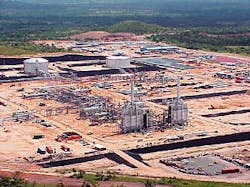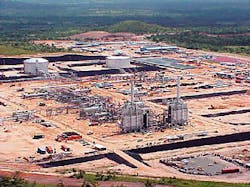Upgraded bituminous crudes boosting world oil supply
Upgraded bituminous crudes are expected to contribute more than 1 million b/d to global oil supplies this year, according to a new analysis by London think tank Centre for Global Energy Studies.
Improvements in technology have increased the commerciality of recovering and upgrading heavy crude oil from large oil sands and extra-heavy crude oil deposits such as those in Alberta and Venezuela's Orinoco oil belt.
Production costs have plunged, and upgrading efficiencies have improved to the extent that this once-marginal resource is beginning to make a noteworthy contribution to world oil supplies. Perhaps even more crucial to world oil markets is the disproportionate impact these new supplies will have on the US, the world's biggest oil market, CGES notes.
The large deposits of bituminous oil in Canada's Alberta oil sands and in the riverbeds of the Orinoco valley in Venezuela are only now becoming a commercial reality, CGES said.
The scale and cost of operations required to produce and upgrade the oil have until recently been too great to allow profitable exploitation, CGES said, but in the space of a few years all that has changed.
Last year Canadians produced more than 650,000 b/d of heavy oil from the Alberta oil sands, and now Venezuelan extra-heavy oil supplies are also reaching the market, potentially adding 400,000 b/d to the country's conventional oil production by yearend.
Although the two regions combined are estimated to contain more than 3 trillion bbl of bituminous oil, far outstripping even the reserves of the Middle East, the volumes produced are likely to be minimal relative to global production, CGES said.
Oil market impact
Nevertheless, the impact on world markets could be disproportionately large because of the proximity of the two heavy oil producers to the US, their primary market.
"Operating costs for the two largest Canadian producers of synthetic crude have been halved in the last 20 years to about $12/bbl. With the high-grade [end-product syncrude] oil trading close to parity with West Texas Intermediate in the US Midcontinent, this makes syncrude operations relatively robust, even when oil prices are low," CGES pointed out.
Canada is already exporting almost 1 million b/d of crude to the US. Although some of the new syncrude will replace declining volumes from conventional production, most of the Canadian syncrude will be sold to refiners in the US Midcontinent, where it will compete directly with WTI and other domestic pipeline grades such as Louisiana Light Sweet.
US Gulf Coast refineries will receive most of the Venezuelan crude, although not all of it will be traded on the spot market. "Two of the three Venezuelan projects currently in operation have long-term contracts with refiners-usually the project's investors-but the third, which will start producing high-quality, low-sulfur syncrude this year, plans to sell the bulk of its output on the Gulf Coast spot market, where it will compete with [US crude] and other imported light, sweet grades," CGES said.

